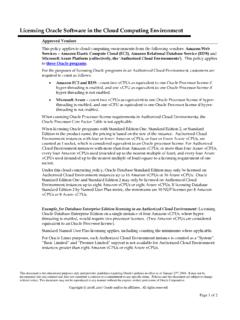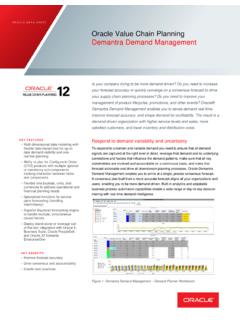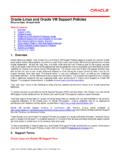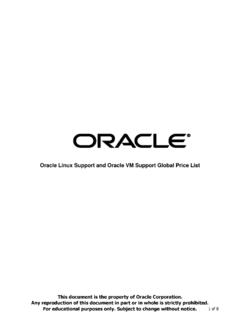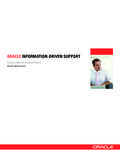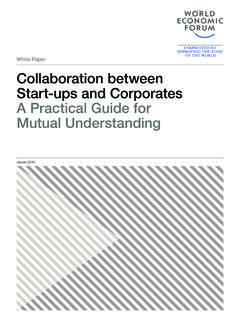Transcription of Five Ways to Simplify Cloud Integration - Oracle
1 Five Ways to Simplify Cloud Integration Oracle Integration Cloud white paper / DECEMBER 2017. DISCLAIMER. This document in any form, software or printed matter, contains proprietary information that is the exclusive property of Oracle . Your access to and use of this confidential material is subject to the terms and conditions of your Oracle software license and service agreement, which has been executed and with which you agree to comply. This document and information contained herein may not be disclosed, copied, reproduced or distributed to anyone outside Oracle without prior written consent of Oracle . This document is not part of your license agreement nor can it be incorporated into any contractual agreement with Oracle or its subsidiaries or affiliates. This document is for informational purposes only and is intended solely to assist you in planning for the implementation and upgrade of the product features described.
2 It is not a commitment to deliver any material, code, or functionality, and should not be relied upon in making purchasing decisions. The development, release, and timing of any features or functionality described in this document remains at the sole discretion of Oracle . Due to the nature of the product architecture, it may not be possible to safely include all features described in this document without risking significant destabilization of the code. 2 W HITE paper / Five Ways to Simplify Cloud Integration TABLE OF CONTENTS. Integration Challenges .. 4. Five Ways to Simplify Cloud Integration .. 5. #1 Prebuilt 5. #2 Recommendations .. 6. #3 Auto Association of Oracle SaaS 7. #4 Intuitive User Experience .. 8. #5 Deployment Flexibility .. 9. Introducing Oracle Integration Cloud .. 10. Conclusion .. 11. 3 W HITE paper / Five Ways to Simplify Cloud Integration Integration CHALLENGES.
3 The rapid shift from on-premise applications to a hybrid mix of Software-as- a-Service (SaaS) and on-premises applications has introduced big challenges for companies attempting to Simplify enterprise application Integration . One reason for this challenge is the ease in which Lines of Business (LOBs, such as marketing, sales, customer support, etc.) can subscribe to multiple disparate SaaS applications with little or no involvement from internal IT. Once the LOB starts using the SaaS. application however, there is often a need to integrate with existing applications. Prior to Oracle Integration Cloud , Integration platforms have been too complicated to easily include participation with LOB application users, resulting in a costly, time consuming, and error prone attempt at Integration . Figure 1. Five Integration challenges - Integration platforms have historically been too complex for LOB.
4 Development collaboration, lack of awareness of installed SaaS application from the PaaS, lack of expert guidance, no pre- Integration requiring even common integrations be developed from scratch and deployment lock-in resulting in the inability to transition based on changing business requirements. Additional challenges include the isolation of the Platform as a Service (PaaS) from the SaaS applications resulting in potential for errors due to version number mismatch, additional upfront set-up and security work. A. unified Cloud containing both PaaS and SaaS presents significant opportunities to pre-populate and automatically associate SaaS. applications into the Integration platform. Next is embedded expert guidance and pre- Integration are key opportunities that have been under 4 W HITE paper / Five Ways to Simplify Cloud Integration utilized within enterprise mission critical Integration platforms to date.
5 Gaining guidance from the many who have done similar integrations within the same Integration platform provides further opportunities for error reduction and faster time to market. And finally, lack of ability to transition deployments between public and private clouds will likely increase in importance to respond to new business demands such as regulations that require pulling a Cloud Integration deployment back on-premise. FIVE W AYS TO Simplify Cloud Integration . Yesterday's Integration approach of manually recreating all of your integrations from scratch is no longer fast enough to keep pace with the rapid growth in LOB acquired SaaS applications. A new approach to application Integration is required. This white paper describes five ways to Simplify Cloud Integration as you transition from a complex, application Integration architecture to a simple and agile Integration platform.
6 The first way to Simplify is with the concept of prebuilt Integration so you don't have to start your integrations from scratch. Next is the ability of the Integration platform to learn best practices based on successful integrations done by other customers and incorporate that machine learning insight as guidance into an embedded mapping recommendation capability. Third is Oracle 's unique ability as a provider of both PaaS and SaaS to leverage your tenant ID to pre-configure connectivity to your SaaS applications into the Integration platform. A fourth way to Simplify is to completely redefine the user experience so all user personas including LOB and Applications IT can collaborate with Integration developers and architects. And finally, Integration deployment flexibility to support dynamic business requirements such as increased business regulations requiring a rapid migration from Cloud to on-premises is an important capability to have a future ready Integration solution.
7 Lets take a deeper look into each of these five key ways to Simplify Cloud Integration .: #1 PREBUILT Integration . Until recently, all integrations needed to be created from the ground up, requiring Integration architecture design, testing, debugging, redesigning due to lessons learned, pushing into production and then fine-tuning some more of the design. This time consuming and costly development cycle may be required for niche integrations that are not common to most businesses. But what about integrations that are used by a wide range of different industries should these common integrations be re-invented by every company? For example, an Integration that tracks the progress of sales leads that originated in a marketing application as they advance through the sales cycle within a CRM. application should not have to be recreated from the ground up by every customer.
8 A prebuilt Integration should be available to jumpstart the Integration for every future Integration . Likewise, recruiting software that automatically updates human resources and security applications once a prospect is hired is not an uncommon request, so why should every company recreate the same Integration ? 5 W HITE paper / Five Ways to Simplify Cloud Integration Figure 2. Example of a prebuilt Integration sharing data between Oracle Sales Cloud and Oracle RightNow Cloud Service. Prebuilts developed by Oracle display the Built by Oracle text. Another common example associated with integrating sales and customer service software would be when a customer has been contacting your customer support recently about critical issues causing serious business disruption of their business. Your customer support service software has fully captured these issues but the software has not communicated the level of dissatisfaction to the local account team.
9 As weeks have gone by, your customer's problems have gotten worse. Some time later, the local account team visits the customer to sell a new product and is caught off guard when the customer explains the damage done by the product issues and the damage to the relationship is done. One simple Integration could have saved a massive amount of current and potential future revenue. To eliminate these types of problems, Oracle Integration Cloud has introduced prebuilt integrations to jumpstart your Integration . Prebuilt Integration transforms Integration platforms from a blank palette upon which you build the Integration from scratch into a run-ready Integration solution that includes all of the set-up for how differently named but identical information (ex: AccountName and Account) is transformed and/or enriched from one application to another. For example, a prebuilt Integration could update quote information from Oracle CPQ Cloud (Configure, Price and Quote) into Oracle Sales Cloud so the sales team has instantaneous visibility into the status and details of a quote.
10 If you want to make custom modifications to the prebuilt, that's fine too. Oracle Integration Cloud lets you take advantage of a growing collection of prebuilt integrations, accessible from the Oracle Cloud Marketplace. Oracle SaaS and on-premise product teams as well as Oracle partners build these integrations. One of the features that elevates Oracle Integration in the industry is the unique ability of Oracle , a provider of both applications and Integration , to leverage its expertise in SaaS application development to deliver Built by Oracle prebuilt integrations directly inside Oracle Integration Cloud . Nobody knows Oracle applications better than Oracle itself. This approach reduces the likelihood of errors and gets you a big step closer to a fully integrated real-time digital business. One of the features that elevates Oracle Integration in the industry is the unique ability of Oracle , a provider of both applications and Integration , to leverage its expertise in SaaS application development to deliver Built by Oracle prebuilt integrations directly inside Oracle Integration Cloud .
